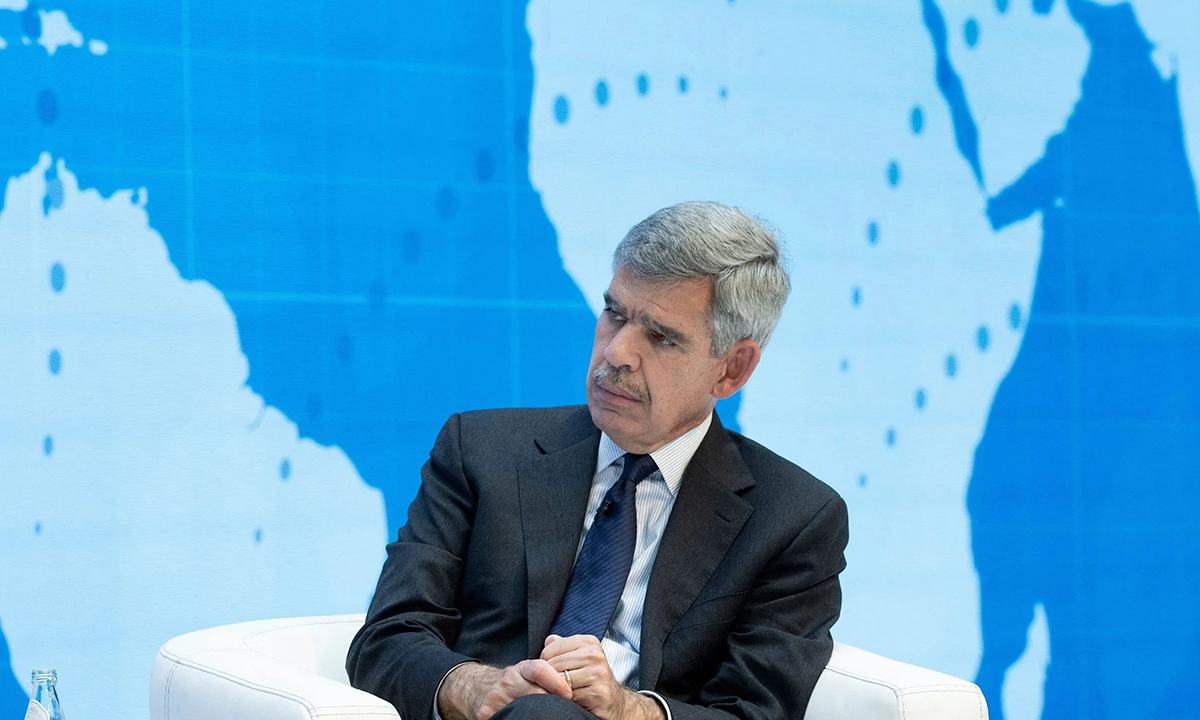
美國(guó)11月的就業(yè)報(bào)告超出預(yù)期,這當(dāng)然值得慶祝,而且大多數(shù)美國(guó)人確實(shí)感到慶幸。但由于通貨膨脹始終接近四十年最高水平,因此對(duì)于美聯(lián)儲(chǔ)而言情況卻截然不同。
美聯(lián)儲(chǔ)官員今年已經(jīng)六次加息,試圖給經(jīng)濟(jì)降溫,將通脹降低到2%的目標(biāo)水平,但到目前為止,他們只是減慢了消費(fèi)物價(jià)上漲速度。
一些經(jīng)濟(jì)學(xué)家認(rèn)為,最新的就業(yè)報(bào)告證明,美聯(lián)儲(chǔ)的措施力度不足以按照預(yù)期平衡勞動(dòng)力市場(chǎng),這意味著通貨膨脹可能難以應(yīng)付。
劍橋大學(xué)(University of Cambridge)皇后學(xué)院(Queens’ College)院長(zhǎng)穆罕默德·埃里安周末對(duì)微軟全國(guó)廣播公司(MSNBC)表示:“本周的數(shù)據(jù)只是表明,美聯(lián)儲(chǔ)依舊行動(dòng)過(guò)晚,力度不足。通貨膨脹問(wèn)題依舊頑固。雖然通脹確實(shí)在下降,但下降速度不足。”
11月,美國(guó)經(jīng)濟(jì)新增26.3萬(wàn)個(gè)就業(yè)崗位,失業(yè)率接近疫情之前的最低水平3.7%。工資同比上漲5.1%,環(huán)比上漲0.6%,為自1月以來(lái)的最快漲幅。
雖然這對(duì)于美國(guó)上班族而言是好消息,但美聯(lián)儲(chǔ)一直希望工資上漲速度能夠放緩,失業(yè)率能夠小幅上升,以協(xié)助其抑制通脹。埃里安警告稱(chēng),在11月份的就業(yè)報(bào)告中有證據(jù)暴露出勞動(dòng)力市場(chǎng)的“供應(yīng)問(wèn)題”可能刺激了通貨膨脹。
他提到勞動(dòng)力參與率下降的趨勢(shì)時(shí)稱(chēng):“未來(lái)前景黯淡。”勞動(dòng)力參與率是指參與工作或積極找工作的人口比例。
上個(gè)月,勞動(dòng)力參與率從疫情之前的63.4%下降至62.1%,在2000年的最高點(diǎn)曾超過(guò)67%。由于空缺崗位的競(jìng)爭(zhēng)者減少,因此勞動(dòng)力市場(chǎng)緊張可能持續(xù)更長(zhǎng)時(shí)間,這會(huì)導(dǎo)致通脹惡化。
埃里安認(rèn)為,最新就業(yè)報(bào)告表明,美聯(lián)儲(chǔ)官員需要保持鷹派立場(chǎng),否則他們可能會(huì)重蹈疫情期間的覆轍:低估通貨膨脹的持久力,導(dǎo)致美國(guó)陷入經(jīng)濟(jì)衰退。
他表示:“想象一下你正開(kāi)車(chē)在高速公路上行駛,你應(yīng)該減速,高速公路變得越來(lái)越危險(xiǎn)……前方有濃霧籠罩。去年,他們就應(yīng)該減速,但他們并沒(méi)有這樣做。他們向我們保證這是暫時(shí)的;濃霧終究會(huì)消散。但事實(shí)上并沒(méi)有。”埃里安在批評(píng)美聯(lián)儲(chǔ)的政策措施時(shí),將濃霧比作通貨膨脹。
埃里安表示,現(xiàn)在美聯(lián)儲(chǔ)正在用力剎車(chē),利用快速加息控制通貨膨脹(走出“迷霧”),但這些措施依舊無(wú)效,這意味著美國(guó)經(jīng)濟(jì)未來(lái)將經(jīng)歷更多痛苦。
他說(shuō)道:“我們已經(jīng)連續(xù)四次加息0.75個(gè)百分點(diǎn);這是史上前所未有的。雖然美聯(lián)儲(chǔ)已經(jīng)踩下剎車(chē),但汽車(chē)并未快速減速。他們?cè)噲D令美國(guó)經(jīng)濟(jì)進(jìn)一步減速。如果他們盡早采取行動(dòng),就能減少對(duì)經(jīng)濟(jì)的不必要損害。很可惜,現(xiàn)在木已成舟。”(財(cái)富中文網(wǎng))
翻譯:劉進(jìn)龍
審校:汪皓
美國(guó)11月的就業(yè)報(bào)告超出預(yù)期,這當(dāng)然值得慶祝,而且大多數(shù)美國(guó)人確實(shí)感到慶幸。但由于通貨膨脹始終接近四十年最高水平,因此對(duì)于美聯(lián)儲(chǔ)而言情況卻截然不同。
美聯(lián)儲(chǔ)官員今年已經(jīng)六次加息,試圖給經(jīng)濟(jì)降溫,將通脹降低到2%的目標(biāo)水平,但到目前為止,他們只是減慢了消費(fèi)物價(jià)上漲速度。
一些經(jīng)濟(jì)學(xué)家認(rèn)為,最新的就業(yè)報(bào)告證明,美聯(lián)儲(chǔ)的措施力度不足以按照預(yù)期平衡勞動(dòng)力市場(chǎng),這意味著通貨膨脹可能難以應(yīng)付。
劍橋大學(xué)(University of Cambridge)皇后學(xué)院(Queens’ College)院長(zhǎng)穆罕默德·埃里安周末對(duì)微軟全國(guó)廣播公司(MSNBC)表示:“本周的數(shù)據(jù)只是表明,美聯(lián)儲(chǔ)依舊行動(dòng)過(guò)晚,力度不足。通貨膨脹問(wèn)題依舊頑固。雖然通脹確實(shí)在下降,但下降速度不足。”
11月,美國(guó)經(jīng)濟(jì)新增26.3萬(wàn)個(gè)就業(yè)崗位,失業(yè)率接近疫情之前的最低水平3.7%。工資同比上漲5.1%,環(huán)比上漲0.6%,為自1月以來(lái)的最快漲幅。
雖然這對(duì)于美國(guó)上班族而言是好消息,但美聯(lián)儲(chǔ)一直希望工資上漲速度能夠放緩,失業(yè)率能夠小幅上升,以協(xié)助其抑制通脹。埃里安警告稱(chēng),在11月份的就業(yè)報(bào)告中有證據(jù)暴露出勞動(dòng)力市場(chǎng)的“供應(yīng)問(wèn)題”可能刺激了通貨膨脹。
他提到勞動(dòng)力參與率下降的趨勢(shì)時(shí)稱(chēng):“未來(lái)前景黯淡。”勞動(dòng)力參與率是指參與工作或積極找工作的人口比例。
上個(gè)月,勞動(dòng)力參與率從疫情之前的63.4%下降至62.1%,在2000年的最高點(diǎn)曾超過(guò)67%。由于空缺崗位的競(jìng)爭(zhēng)者減少,因此勞動(dòng)力市場(chǎng)緊張可能持續(xù)更長(zhǎng)時(shí)間,這會(huì)導(dǎo)致通脹惡化。
埃里安認(rèn)為,最新就業(yè)報(bào)告表明,美聯(lián)儲(chǔ)官員需要保持鷹派立場(chǎng),否則他們可能會(huì)重蹈疫情期間的覆轍:低估通貨膨脹的持久力,導(dǎo)致美國(guó)陷入經(jīng)濟(jì)衰退。
他表示:“想象一下你正開(kāi)車(chē)在高速公路上行駛,你應(yīng)該減速,高速公路變得越來(lái)越危險(xiǎn)……前方有濃霧籠罩。去年,他們就應(yīng)該減速,但他們并沒(méi)有這樣做。他們向我們保證這是暫時(shí)的;濃霧終究會(huì)消散。但事實(shí)上并沒(méi)有。”埃里安在批評(píng)美聯(lián)儲(chǔ)的政策措施時(shí),將濃霧比作通貨膨脹。
埃里安表示,現(xiàn)在美聯(lián)儲(chǔ)正在用力剎車(chē),利用快速加息控制通貨膨脹(走出“迷霧”),但這些措施依舊無(wú)效,這意味著美國(guó)經(jīng)濟(jì)未來(lái)將經(jīng)歷更多痛苦。
他說(shuō)道:“我們已經(jīng)連續(xù)四次加息0.75個(gè)百分點(diǎn);這是史上前所未有的。雖然美聯(lián)儲(chǔ)已經(jīng)踩下剎車(chē),但汽車(chē)并未快速減速。他們?cè)噲D令美國(guó)經(jīng)濟(jì)進(jìn)一步減速。如果他們盡早采取行動(dòng),就能減少對(duì)經(jīng)濟(jì)的不必要損害。很可惜,現(xiàn)在木已成舟。”(財(cái)富中文網(wǎng))
翻譯:劉進(jìn)龍
審校:汪皓
November’s stronger-than-expected jobs report should be cause for celebration, and it is for most Americans. But with inflation sitting near a four-decade high, it’s a different story for the Federal Reserve.
Fed officials have raised interest rates six times this year in an attempt to cool the economy and reduce inflation to their 2% target rate, but so far they’ve managed only to slow the pace of consumer price increases.
And some economists say the latest jobs report is evidence that the Fed’s policies haven’t done enough to balance the labor market as intended—which means inflation could be sticky.
“If anything, this week’s numbers suggest that the Fed is still doing too little, too late,” Mohamed El-Erian, the president of Queens’ College at the University of Cambridge, told MSNBC over the weekend. “Inflation remains a problem. Yes, it’s coming down, but it’s not coming down fast enough.”
The U.S. economy added 263,000 jobs, and the unemployment rate stuck near pre-pandemic lows at 3.7% in November. Wages also rose 5.1% from a year ago and 0.6% month over month—the fastest pace since January.
While this is good news for American workers, the Fed has been hoping the pace of wage increases would slow and unemployment would mildly increase to aid its inflation fight. El-Erian warned that there is evidence of “supply issues” in the labor market in November’s jobs report that could boost inflation as well.
“There are clouds on the horizon,” he said, pointing to the falling labor force participation rate—the percentage of the population that works or is actively seeking work.
The labor force participation rate dropped to 62.1% last month, from 63.4% prior to the pandemic—it peaked at over 67% in the year 2000. With fewer workers competing for open positions, the labor market could remain tighter for longer, exacerbating inflation.
El-Erian argued that the latest jobs report shows Fed officials need to remain hawkish, otherwise they could commit the same error that they did during the pandemic era: underestimating the staying power of inflation, leading to a U.S. recession.
“Think of it as if you’re driving on the freeway and you should be slowing down, the freeway is getting more treacherous…there’s fog on the horizon,” he said, equating fog to inflation as he described the Fed’s policy error. “Last year, they should have slowed down, but they didn’t. They assured us that this was transitory; the fog was going to lift. Well, it didn’t lift.”
Now, El-Erian said, the Fed is slamming on the brakes with rapid rate hikes to fight inflation (get out of the “fog”), and it’s still not working, which means Americans will experience even more economic pain moving forward.
“We’ve had four consecutive 0.75 percentage point [interest rate] increases; that’s never happened in history before. Having hit the brakes, the car hasn’t slowed down enough,” he said. “They’re trying to slow us down even more. Had they started earlier, there would be less undue damage to the economy. But unfortunately, we are where we are.”






